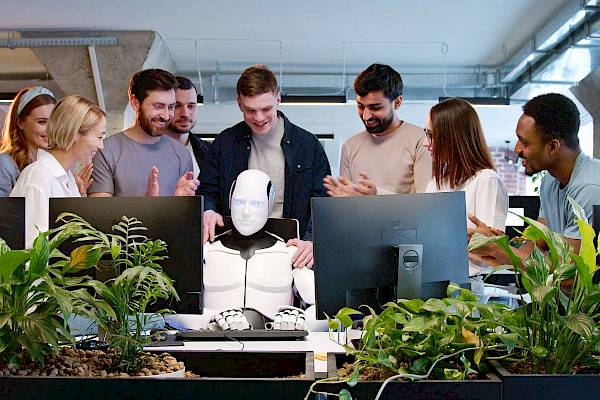In this month's Target Tech Bytes, let’s immerse ourselves in the intriguing world known as the Metaverse. Here you’ll learn what it is, some pros and cons and how it has the potential to transform the way we interact with banks and fintech.
The name itself conjures up a futuristic vision, but what really is the Metaverse and is it as far away from existence as we may think?
The Oxford Languages definition of Metaverse is short and sweet:
Metaverse
noun: Metaverse; plural noun: Metaverses
- a virtual-reality space in which users can interact with a computer-generated environment and other users.
What is the Metaverse?
Referred to by some as the next adaptation of the internet, the Metaverse aims to be a persistent, three-dimensional shared virtual universe that’s decentralised and accessible to everyone via the internet. It’s a digital realm where users can interact socially and professionally with each other using a manifestation of themselves called an avatar, achieved through a range of interoperable hardware and software used in tandem.
A 3D enhancement to the traditional way we use the internet as we know it!
The integration of augmented reality (AR), mixed reality (MR) and virtual reality (VR) technology will enable the Metaverse to entice users into a virtual world where anything is possible.
Author and entrepreneur Jon Radoff proposed the seven layers of the Metaverse:
- Layer 1: Experience
- Layer 2: Discovery
- Layer 3: Creator Economy
- Layer 4: Spatial Computing
- Layer 5: Decentralisation
- Layer 6: Human Interface
- Layer 7: Infrastructure
Gartner predicts that by 2026, 25% of people will spend at least one hour per day in the Metaverse for work, shopping, education, or entertainment.
A brief history
The concept of a 3D immersive internet and the technologies that would underpin it date back decades. Yet the term Metaverse was only coined in 1992 by the American author Neal Stephenson in his sci-fi novel Snow Crash. He wrote about people who would escape the physical world by wearing goggles and disappearing into the Metaverse.
‘So Hiro's not actually here at all. He's in a computer-generated universe that
his computer is drawing onto his goggles and pumping into his earphones. In the
lingo, this imaginary place is known as the Metaverse. Hiro spends a lot of
time in the Metaverse'
― Neal Stephenson, Snow Crash
The underpinning technologies
Advancements in technologies that serve as enablers for the Metaverse to provide that fully immersive, digital representation of reality are progressing at pace.
Below is a brief overview of some of those technologies that power Metaverse applications to provide that futuristic experience:
- Augmented, virtual reality and mixed reality
- AR adds virtual elements to the physical world, seamlessly blending the physical and digital world, for example, Snapchat filers or Pokemon Go
- VR is a complete virtual simulation of a real-world scenario, often discovered through a VR headset
- MR is a blend of both AR and VR and where users can interact with the digital display, such as a projected keyboard
- Blockchain
- The decentralised and immutable blockchain will help scale the Metaverse by allowing users to own their digital identities and enable secure digital e-commerce. Non-Fungible Tokens (NFTs) allow creators to claim ownership of their virtual creations
- Artificial intelligence
- The use of AI will give environments and avatars lifelike features and qualities. AI chatbots and virtual assistants will also allow users to interact with virtual entities
- Edge computing
- Bringing data closer to the user rather than processing and storing at data centres. It reduces latency and enables the collection and processing of data in real-time for a seamless experience
- 5G
- The Metaverse requires huge amount of power to connect virtual experiences with users, 5G has the bandwidth and power needed for real-time data transfers.
What are the pros and cons to the Metaverse
As with previous topics covered in Target Tech Bytes, the Metaverse has a variety of pros and cons depending on its application:
Pros
- Allows users to dive into immersive reality and experiences that they wouldn’t usually get the opportunity to do in real life, such as climbing Kilimanjaro or watching their favourite band at a concert, all from the comfort of their home
- It will revolutionise the way we socialise, breaking down geographical barriers and allowing users from across the world to connect with each other
- Using virtual environments, the Metaverse could have a positive environmental impact by reducing the need for people to travel, curbing carbon emissions
- Immersive virtual environments can support medical and scientific progress by enhancing diagnostics and allowing surgeons to collaborate on medical outcomes.
Cons
- The Metaverse would process and store huge amounts of data. Privacy and security concerns are high and would need to be addressed to ensure user safety
- To access the Metaverse, users would require a fast internet connection and a compatible device(s). This could set a digital divide to those without this access
- There is a potential that spending so much time in a virtual world may blur the line between the virtual and physical world, causing a rise in addiction and health issues
- Hyper reality in gaming may cause desensitisation to violence, contributing to social problems and even crime.
Ultimately wider adoption of the Metaverse will need new forms of policing and regulation to protect users, particularly children and vulnerable people.
Is anyone using it yet?
Whilst the Metaverse as a complete virtual world remains a theory, gaming experiences such as Decentraland, Roblox and Fortnite are used by millions of people and already provide an insight into what an immersive 3D environment would be like. These are regarded as early-metaverses.
Big tech companies such as Meta and Google are investing huge amounts of money in developing their versions of the Metaverse, making it a hot topic for investors, competitors, and consumers.
How will it impact banking and fintech firms?
A report by Mckinsey stated that by 2030 the Metaverse could be worth $5 trillion and is potentially the biggest new growth opportunity for several sectors, including financial services.
The potential of the Metaverse in everyday life is vast. It could impact everything from education, socialising, healthcare and finance.
In Banking, branches are closing at an exponential rate so the Metaverse could be the solution to reigniting face-to-face banking, but with a virtual twist. Today’s digitally native consumers, who prefer to engage with financial services firms in a way in which they feel comfortable, online, are likely to be accepting of a virtual platform that will allow them to do just that.
How could it support your business
Be an early adopter in technology and give yourself significant advantage over other financial services firms. By exploring the possibilities of the Metaverse and the technologies that go hand in hand, you could put your business in a leading position amongst competitors and when looking to attracting top talent.
Sources
https://www.encora.com/insights/5-technologies-that-are-powering-the-Metaverse
https://www.techtarget.com/searcherp/feature/AR-vs-VR-vs-MR-Differences-similarities-and-manufacturing-uses
https://www.forbes.com/sites/bernardmarr/2022/11/16/banking-in-the-Metaverse--the-next-frontier-for-financial-services/
https://www.gartner.com/en/newsroom/press-releases/2022-02-07-gartner-predicts-25-percent-of-people-will-spend-at-least-one-hour-per-day-in-the-metaverse-by-2026
https://www.goodreads.com/work/quotes/493634-snow-crash
https://101blockchains.com/pros-cons-of-Metaverse/
https://www.mckinsey.com/capabilities/growth-marketing-and-sales/our-insights/value-creation-in-the-metaverse
https://medium.com/building-the-metaverse/the-metaverse-value-chain-afcf9e09e3a7




